In a course that I was taking as part of my Master’s program that provided an introduction to game-based teaching, I had the chance to learn about the benefits of adopting curricular games when developing a learning experience. As an instructional designer who has seen the impact of games on people and their ability to teach life skills, I will share with you five reasons why I see game-based teaching (GBT) as a winning approach when it comes to developing learning experiences in the 21st century.
“Games aren’t just filler in education. They have the ability to introduce, reinforce, or even assess learning of a given topic”
Kara Carrero
- Engaging and Entertaining Experience:
None of us would be happy to see our students distracted from what we are teaching, therefore, we put a lot of effort into ensuring that we keep the learners engaged. Curricular games are a great technique to do so! Let us think of a time when you played a game such as Monopoly or Grand-Theft Auto or any game you loved, do you remember how you felt? Can you think of skills you learned through these games? Did you feel bored? If you are like me, most probably you were engaged in a flow state that you didn’t even feel the hours passing by when playing, and possibly you learned various skills such as coordination, decision making, critical thinking, and time management. Well-designed games can be a great entertainment and learning tool, not only to transfer knowledge but also to develop soft skills that are required in the employment world today.
2. Risk Without the Consequences:
Teaching through games encourages learners to make hard decisions and take risks that they might not be able to do in real life. This is due to the ability of games to simulate real-life events and situations without actually having real consequences. The player who is the learner will be more comfortable taking steps or actions that they might avoid in real life only because they are afraid of the result this decision can bring. For instance, in a soccer video game, the player might try a new playing mechanism or strategy without being afraid of losing a point because they know that the loss will only be in the game and not in real life.
3. From the Game to Reality:
Since games are built on real-life situations and events, the player with proper design and direction from the teacher, trainer, or the game itself will see the connection between the curricular game and real-life situations. In such conditions, the player or learner tends to find it easier to develop the connections between the game world and the real world, thus the learner will be able to apply the skills they learned in the game in real-life situations. For example, going back to the game Monopoly players can take the investment skills and strategies they learned while playing the game and apply them to real-life conditions.
4. Special Ed and ELL Students are Welcomed:
Game-based teaching can be a good choice for the educator who teaches English language or special education learners as it provides scaffolding based on the learner’s needs and offers customized directions and challenges. GBT also encourages collaborative learning which is an effective learning approach when teaching ELL and Special Ed students. Collaboration in games takes place during playing among teams or with other players. If you are a teacher focusing on ELL or special Ed students check the experience of Maile Hoyt, a special education teacher in Texas, when using games for teaching her students. Additionally, game-based learning aligns with the universal design learning (UDL) framework making it a great choice for classrooms with students who have different needs.
5. Roots in Learning Theories:
What I also like about game-based teaching and using curricular games to develop a unique learning experience is that GBT has roots in various well know learning theories. Among these theories come the zone of proximal development (ZPD) and Vygotsky’s scaffolding theories, just-in-time instructions, experiential learning, and social cognitive learning. The discussion about the roots of GBT in dominating learning theories needs a separate post, but might encourage you to look into it and is key if you need to convince your institute, parents, or students about the effectiveness of GBT.
Let’s make this short, if you are an educator and looking for a technique that would bring life to your classroom or the learning experiences you develop, I encourage you to look more into curricular games design and game-based teaching. And if you are already using this technique I would love to hear your experience.
]]>Why did I do so? Merely because if I wanted to learn, I had to start with a new slate. This was necessary for me to be able to absorb new information without it being filtered through the layers of knowledge and experience I have built over the years, I wanted to marginalize constructivism learning theory at this stage if that is possible. Let me share an example of the importance of this phase, in business we use the term SMEs to refer to small and medium-sized enterprises, while in instructional design we use it to refer to subject matter experts. It’s as simple and confusing as that! The good thing with coming from a different background is that I don’t have to unlearn things in the field itself that I might have learned incorrectly, instead I am starting a new page and getting the proper knowledge on it.
“If I wanted to learn, I had to start with a new slate“
Now after a year in the program and taking seven courses so far, I have come along way, currently, I wear both lenses the business one and the instructional design one, I am happy with the outcomes because learning is part of everything and business as well. I find that both fields complement each other for me. I use business skills such as communication, project management, budgeting, and planning in my instructional design work, and vice versa!
My interest and experience in entrepreneurship are reflected in my choices of projects and topics to work on in my instructional design program. I have a goal of building an open-source learning material for business owners to help them with developing the skills they need to manage their business. This might sound ambitious but it is not impossible.
Yes, I have taken a shift, but I did not press delete! I still use my previous knowledge and experience to develop my unique take on both worlds.
Have you shifted from a completely different field to instructional design? would love to hear about your experience.
Featured image by Sayed Ali on Unsplash
]]>After doing extensive research, reading, completing a couple of MOOCs, and social learning I realized that I tapped into a grey area. At first, I thought it all made sense until I realized that instructional design and user experience design are two different fields that seem to have little awareness of each other. Generally, the different opinions I have observed brought me to two streams of thoughts, first, the concept of learning experience design, and second that user experience design will take over instructional design. I found the two notions are not completely true, mainly because they look at one side of the equation, but before I continue with my findings let’s look into the most important terms that I will come across in this post.
Instructional Design (ID)
According to the Association of Talent Development, instructional design is the creation of learning experiences and materials in a manner that results in the acquisition and application of knowledge and skills. The discipline follows a system of assessing needs, determining learning objectives, developing materials, and evaluating their effectiveness.
Learning Experience Design (LXD)
LXD.org defines Learning experience design as the process of creating learning experiences that enable the learner to achieve the desired learning outcome in a human-centered and goal-oriented way. In LXD the focus in on the learner and the process that the learner goes through.
User Experience Design (UXD)
The Nielsen Norman Group co-founded by professor and author Don Norman states that User experience encompasses all aspects of the end-user’s interaction with the company, its services, and its products. User experience design is the process of supporting user behavior through usability, usefulness, and desirability provided in the interaction with a product. UX designers employ design thinking processes to reconcile user’s needs with technical feasibility and business viability.
User Interface Design (UI)
Interaction Design Foundation defines user interface design as the process designers use to build interfaces in software or computerized devices, focusing on looks or style, UI design refers to graphical user interfaces and other forms—e.g., voice-controlled interfaces.
ID vs. LXD
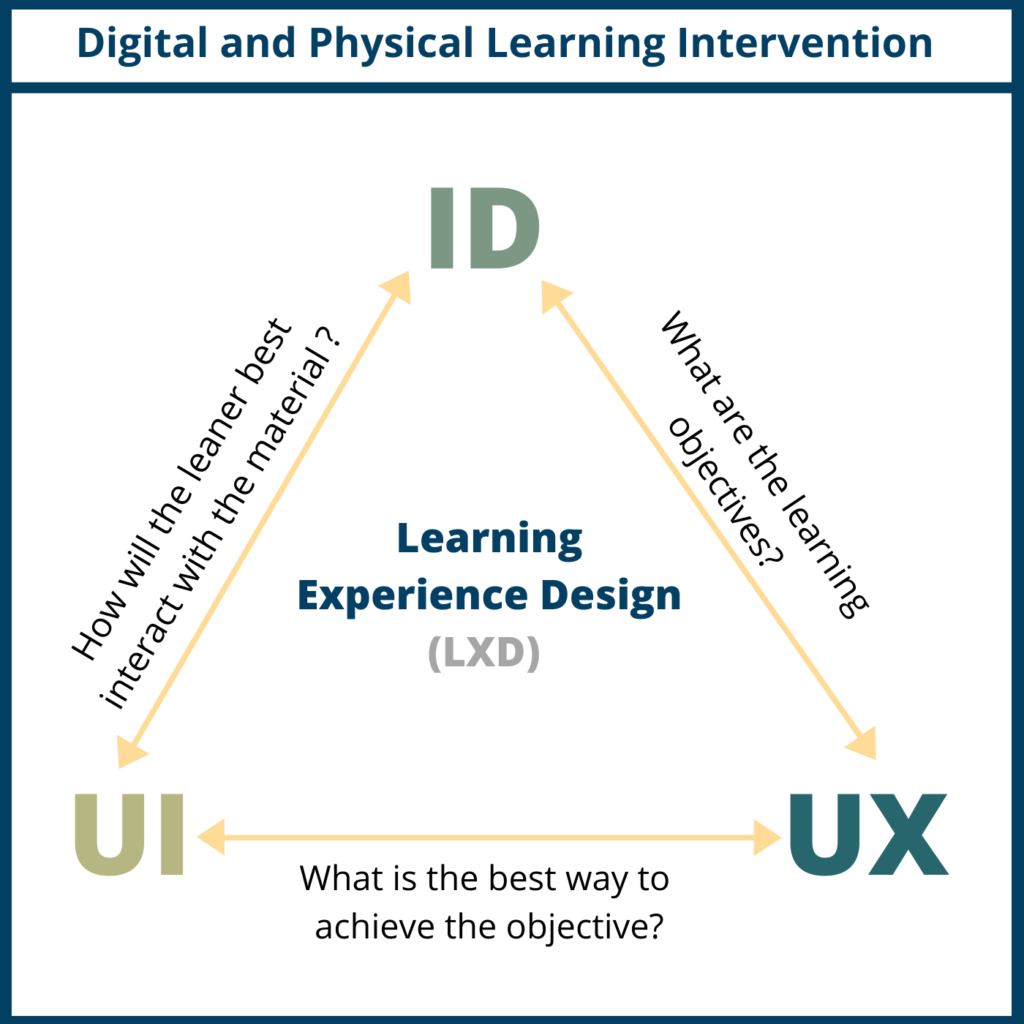
Exploring the relationship between ID and UXD most of the time led me to the concept of learning experience design (LXD). Supporters of this opinion made it as simple as ID + UX=LXD. The difference they made between ID and LXD is that instructional design focused on the instructions and instructor, while learning experience design focused on the learning and the learning process. I disagree with this opinion, it cannot be as simple as this equation is showing, because ID is broader than is claimed. Instructional design puts the learner as the center of the process. It analysis learners, their context, needs, and then uses the best pedagogical practices to deliver the learning. An opinion that I support, is that Learning experience design is the new name of instructional design because it fairly represents the work done by instructional designers and makes it easier for others to immediately understand what instructional designers do. However, using UX and UI design principles in addition to ID to develop training material will result in a rich learning experience outcome.
ID vs. UXD
Some of the opinions that I came across during my research is that UXD will take over instructional design because it is more user-centered, and that is what eLearning needs. Though using UX guidelines for designing learning material especially eLearning is very beneficial and adds great value to instructional designers, I still do not think that user experience designers will be able to replace instructional designers, mainly because UX designers do not have a pedagogical experience. Learning is not about usership only, it is about knowledge transfer using effective learning theories and tools.
Looking at both processes of ID and UX we can find many similarities. They both involve analysis of user or learner, aim to develop an effective and user-friendly experience, and achieve the set goal.
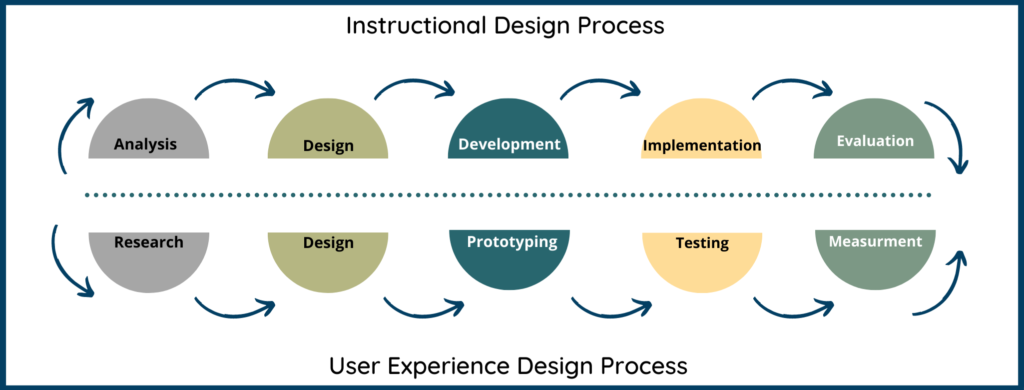
Roles Comparison
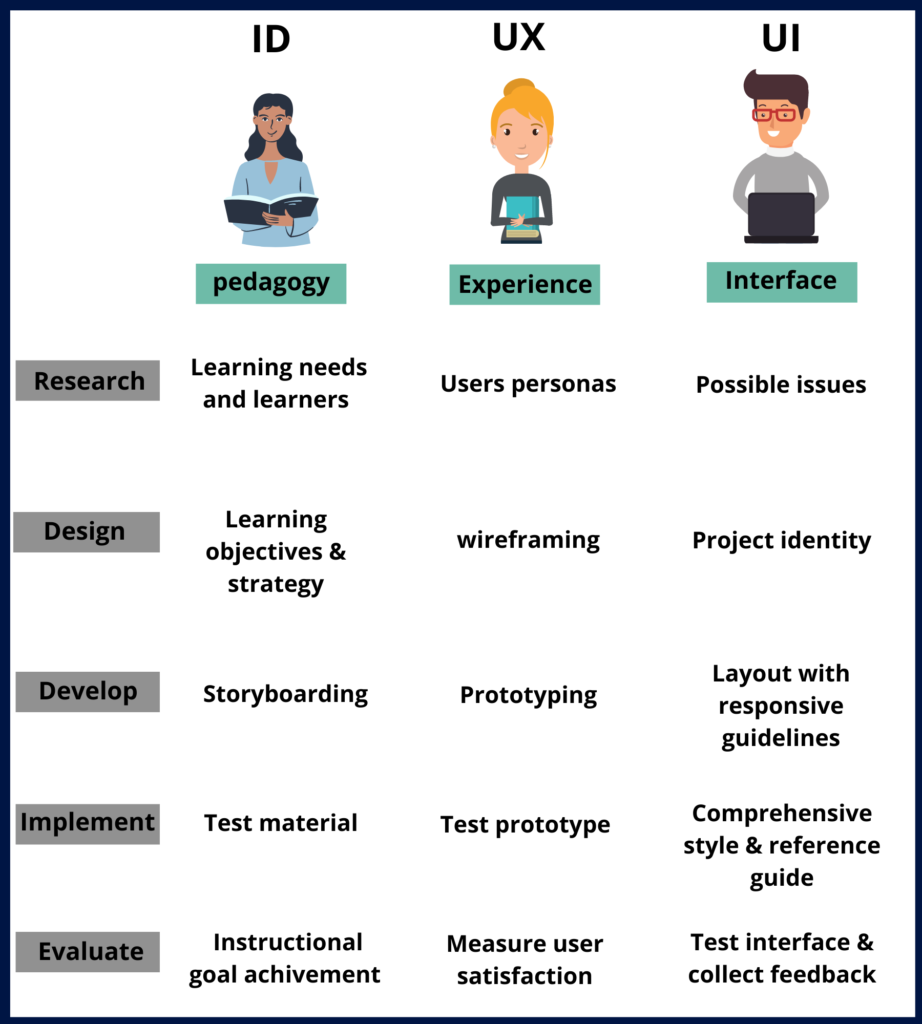
ID and UI
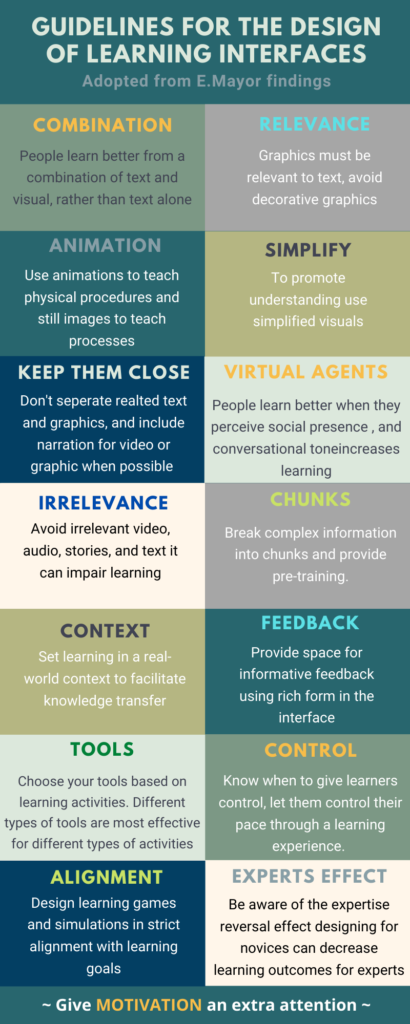
The relationship between Instructional design and user interface design is derived from the ability to use interface design principles to eLearning material or physical training material as well. User interface design is applied on the interface the user interacts with, for example in an eLearning training UI design principle applies to navigation buttons, font, white space. Typography, images, video, text are an example of a physical material that can make use of UI principles. What UI principles can add to ID is providing useful guidelines and tips for designing learning assets such as videos, info-graphic, and eLearning modules interface.
How do they work together?
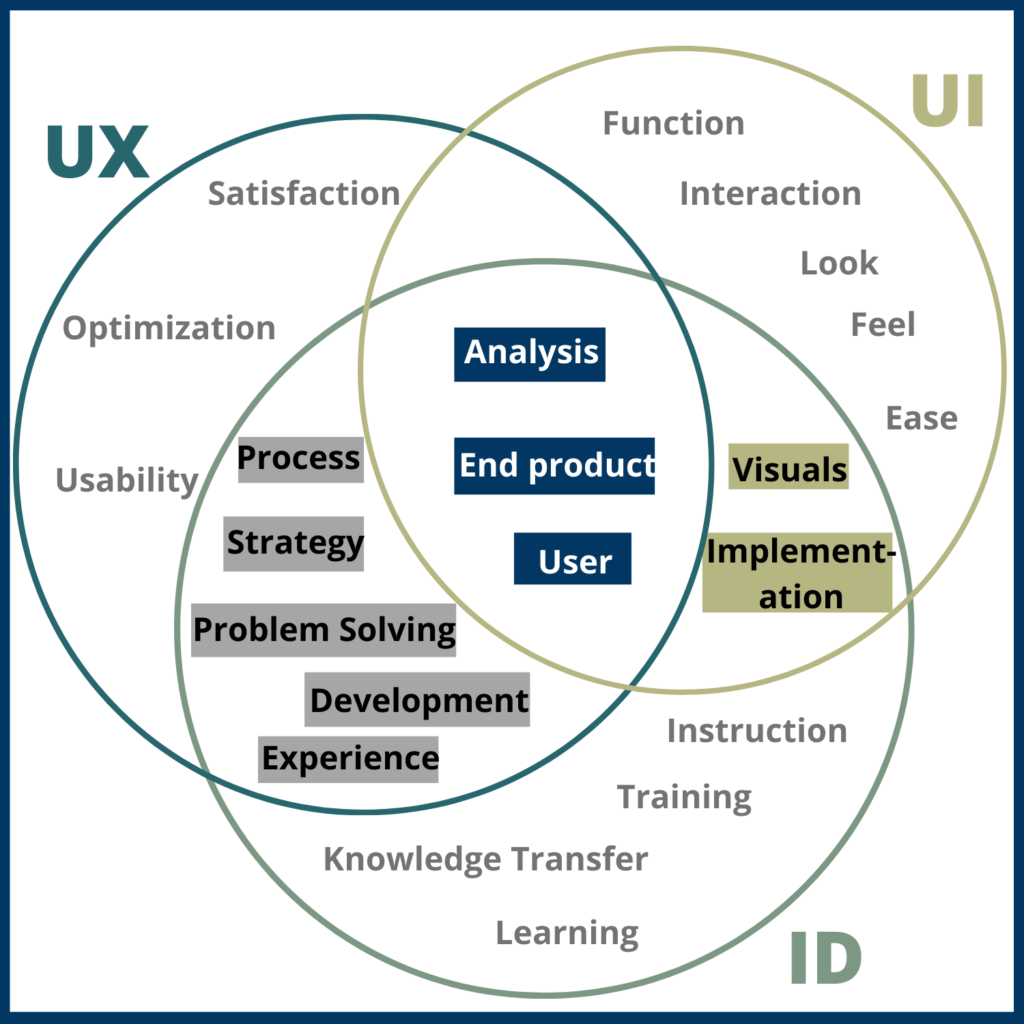
Applying UX and UI principles in ID is very beneficial for the outcome, it will result in a better experience in general when putting all into consideration. However, due to the similarities between UX and ID, there might be minor additions when the instructional designer is working on the full instructional design process. The ability to fully apply the principles can be impacted by the size of the team, if an instructional designer is individually working on a learning experience, they might not be able to fully accommodate all UX and UI principles, and following ID or LXD principles will make them end with a good learning experience; however, if working within a big team to design, then having a UX designer and UI designer on board can be of a great added value.
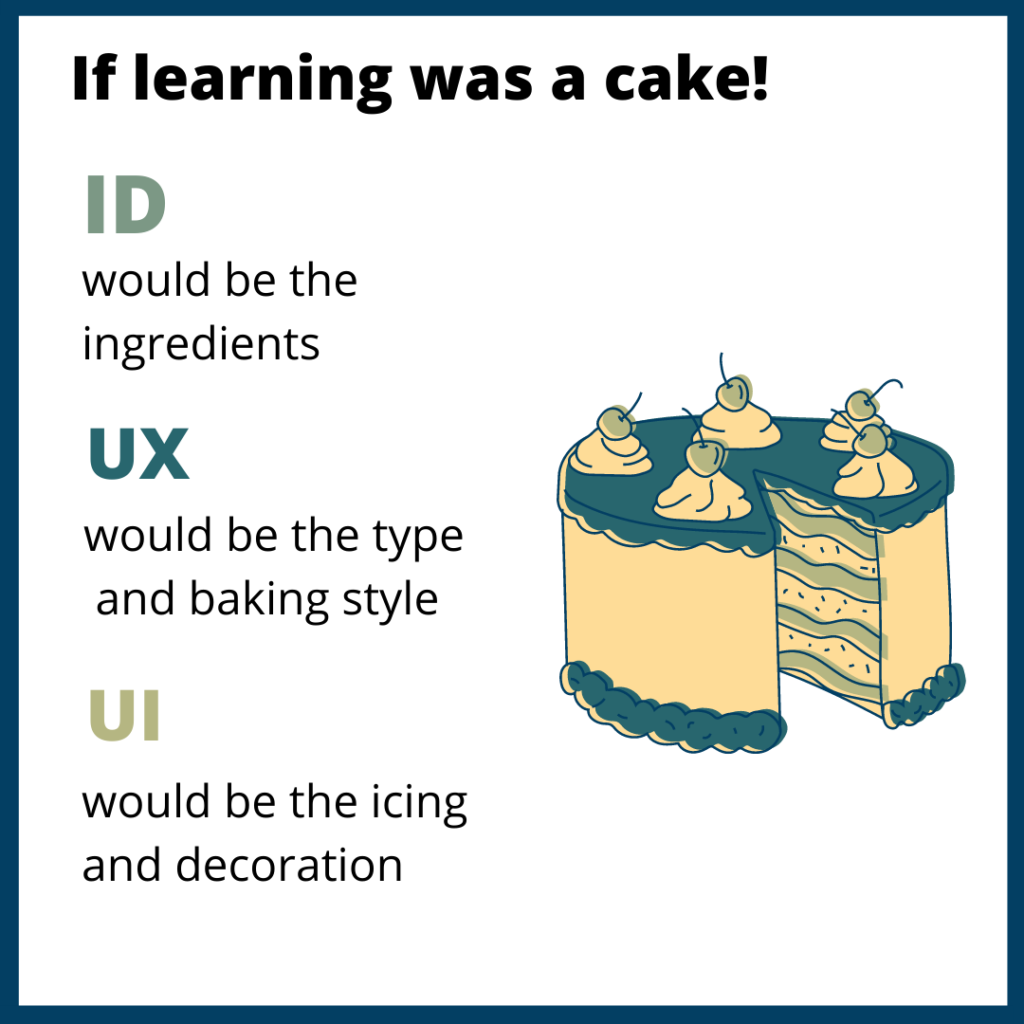
At the end of my research I found out that there are a lot of similarities between UX and ID, but each is being applied in a different field. UX and UI design complement instructional design in producing an efficient, eye-pleasing, and user-friendly learning experiences. I like to use the cake analogy, it gives it some sense.
This was my takeout on the association between ID, UXD, and UI design; would love to hear a different point of view from you on this matter.
Featured image by UX Indonesia on Unsplash
]]>